 W
WA uniform is a type of clothing worn by members of an organization while participating in that organization's activity. Modern uniforms are most often worn by armed forces and paramilitary organizations such as police, emergency services, security guards, in some workplaces and schools and by inmates in prisons. In some countries, some other officials also wear uniforms in their duties; such is the case of the Commissioned Corps of the United States Public Health Service or the French prefects. For some organizations, such as police, it may be illegal for non members to wear the uniform.
 W
WBloomers, also called the bloomer, the Turkish dress, the American dress, or simply reform dress, are divided women's garments for the lower body. They were developed in the 19th century as a healthful and comfortable alternative to the heavy, constricting dresses worn by American women. They take their name from their best-known advocate, the women's rights activist Amelia Bloomer.
 W
WA burka is a coat made from felt or karakul. See article "Burqa" for the etymology of the word.
 W
WThe traditional chef's uniform includes a toque blanche, white double-breasted jacket, pants in a black-and-white houndstooth pattern, and apron. It is a common occupational uniform in the Western world. In the middle ages, chefs had a high public standing similar to doctors, which may be a reason for wearing white. The chef buttons also have a meaning; while qualified chefs wear black buttons, students wear white buttons. Kitchen brigades used to be massive, although today, chefs must be occupied in various areas of the kitchen, thus, being in charge for only one section is hardly possible anymore.
 W
WA cockade is a knot of ribbons, or other circular- or oval-shaped symbol of distinctive colours which is usually worn on a hat.
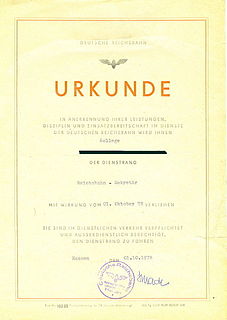 W
WSince its beginning until the year 1991, service rank was a permanent element of service with the Deutsche Reichsbahn, whether as a civil servant or as an employee. Every railroad employee was obliged to wear the conferred insignia while on duty and entitled to do so off duty. The service rank was conferred with a certificate. The first conferral was designated as a certification, each additional conferral as a promotion.
 W
WDiplomatic uniforms are ornate uniforms worn by diplomats—ambassadorial and consular officers—at public occasions. Introduced by European states around 1800 and patterned on court dress, they were abandoned by most countries in the twentieth century, but diplomats from some countries retain them for rare, formal occasions.
 W
WFull dress uniform or parade dress uniform is the most formal type of uniforms used by military, police, fire and other public uniformed services for official parades, ceremonies, and receptions, including private ones such as marriages and funerals. Full dress uniforms typically include full-size orders and medals insignia. Styles tend to trace back to uniforms used during the 19th century, although the 20th century saw the adoption of mess-dress styled full-dress uniforms. Designs may depend on regiment or service branch. In Western dress codes, full dress uniform is a permitted supplementary alternative equivalent to the civilian white tie for evening wear or morning dress for day wear – sometimes collectively called full dress – although military uniforms are the same for day and evening wear. As such, full dress uniform is the most formal uniform, followed by the mess dress uniform.
 W
WFacial hair in the military has been at various times common, prohibited, or an integral part of the uniform.
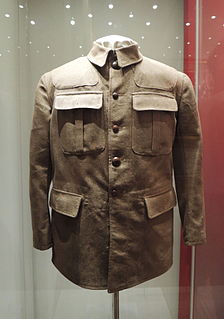 W
WFrench was the designation of a particular type of military jacket or tunic in the Russian Empire and later in the Union of Soviet Socialist Republics (USSR).
 W
WGalloon is a decorative woven trim sometimes in the form of a braid and commonly made of metallic gold or silver thread, lace, or embroidery. Galloon is used in the trim of military and police uniforms, ecclesiastical dress, and as trim on textiles, drapery, and upholstery.
 W
WDetainees held at the US-run Guantanamo Bay detention camp are typically issued one of two uniforms, either a white jumpsuit if the prisoner has been labeled "compliant", or an orange jumpsuit if the detainee has been labeled "non-compliant".
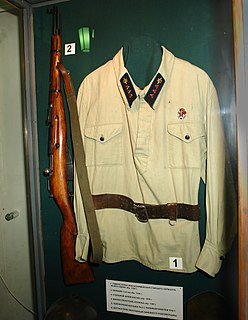 W
WGymnastyorka was a Russian military smock comprising a pullover-style garment with a standing collar having double button closure. Additionally, one or two upper chest pockets, with or without flaps, may have been worn. It had provision for shoulder boards and sometimes reinforced elbows and cuffs. The Tsarist version had the standing collar while the M35 version had a stand-and-fall collar which was replaced with the standing collar in the M43 version. The Soviet Army M35 version usually had hidden buttons. A double breasted version (kitel) for officers of all ranks existed during the Tsarist period.
 W
WA gymslip is a sleeveless tunic with a pleated skirt most commonly seen as part of a school uniform for girls. The term "gymslip" primarily refers to the school uniform; otherwise the term pinafore dress or jumper dress is usually preferred.
 W
WA livery is a uniform, insignia or symbol adorning, in a non-military context, a person, an object or a vehicle that denotes a relationship between the wearer of the livery and an individual or corporate body. Often, elements of the heraldry relating to the individual or corporate body feature in the livery. Alternatively, some kind of a personal emblem or badge, or a distinctive colour, is featured.
 W
WA mascot is any human, animal, or object thought to bring luck, or anything used to represent a group with a common public identity, such as a school, professional sports team, society, military unit, or brand name. Mascots are also used as fictional, representative spokespeople for consumer products, such as the rabbit used in advertising and marketing for the General Mills brand of breakfast cereal, Trix.
 W
WA miner's habit is the traditional dress of miners in Europe. The actual form varies depending on the region, the actual mining function, and whether it is used for work or for ceremonial occasions.
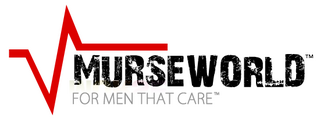 W
WMurse World, is an American company headquartered in New Jersey that sells scrubs and accessories such as stethoscopes for use by male nurses and other medical professionals. Murse World is an online store that resells merchandise directly to consumers via its own website.
 W
WA nurse uniform is attire worn by nurses for hygiene and identification. The traditional nurse uniform consists of a dress, apron and cap. It has existed in many variants, but the basic style has remained recognizable.
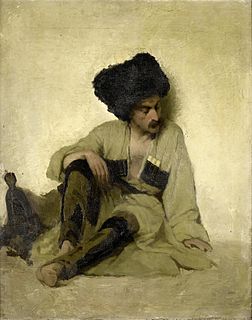 W
WPapakha, is a wool hat worn by men throughout the Caucasus and also in uniformed regiments in the region and beyond. The word papakha is of Turkic origin (papak). In Azerbaijani, papaq translates to hat.
 W
WA Playboy Bunny is a waitress at a Playboy Club. In the original Playboy Clubs that operated between 1960 and 1988, the Playboy bunnies were selected through standardized training and wore a "bunny suit" costume inspired by the tuxedo-wearing Playboy rabbit mascot. This costume consisted of a strapless corset teddy, bunny ears, black sheer-to-waist pantyhose, a bow tie, a collar, cuffs and a fluffy cottontail. In more recent Playboy Clubs, such as Sin City that was re-opened in 2006, Playboy bunnies wore slightly redesigned costumes that were based on the original bunny suit.
 W
WA prison uniform is the unified outward appearance of detainees in a situation of imprisonment. It is typically adapted under constraint.
 W
WA sailor suit is a uniform traditionally worn by enlisted seamen in a navy or other governmental sea services. It later developed into a popular clothing style for children, especially as dress clothes.
 W
WThe Salvation Army bonnet was a millinery design worn by female members of the Salvation Army. It was introduced in 1880 in the UK and was worn as headgear by most female officers in western countries. It began to be phased out from the late 1960s.
 W
WThe Sam Browne belt is a wide belt, usually leather, supported by a narrower strap passing diagonally over the right shoulder. It is most often a part of a military, para-military or police uniform.
 W
WScrubs are the sanitary clothing worn by surgeons, nurses, physicians and other workers involved in patient care in hospitals. Originally designed for use by surgeons and other operating room personnel, who would put them on when sterilizing themselves, or "scrubbing in", before surgery, they are now worn by many hospital personnel. Their use has been extended outside hospitals as well, to work environments where clothing may come into contact with infectious agents. Scrubs are designed to be simple, easy to launder, and cheap to replace if damaged or stained irreparably. In the United Kingdom, scrubs are sometimes known as theatre blues.
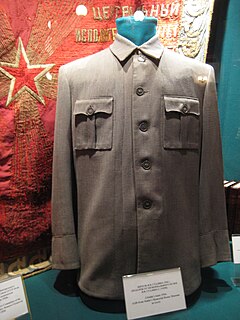 W
WThe Stalin tunic or Stalinka is a type of tunic or jacket associated with Joseph Stalin; from the 1920s until the 1950s and beyond, it was commonly worn as a political uniform by government officials in the Soviet Union.
 W
WStudent boilersuit are boilersuits widely used for specific events at universities and polytechnics in Sweden, Finland, and Canada. Typically, the suits are procured by the student associations of faculties or programmes. At the major Swedish universities the use of boilersuits is limited to engineering students, but their use has spread to students in other fields at some of the smaller university colleges. In Finland, boilersuits have also been foremost identified with engineering students, but see extensive use in all of the student organizations of Finnish institutions of higher learning, such as University of Helsinki and Aalto University.
 W
WUniformology is a branch of the auxiliary sciences of history which studies uniforms - especially military uniforms - through ages and civilizations.
 W
W